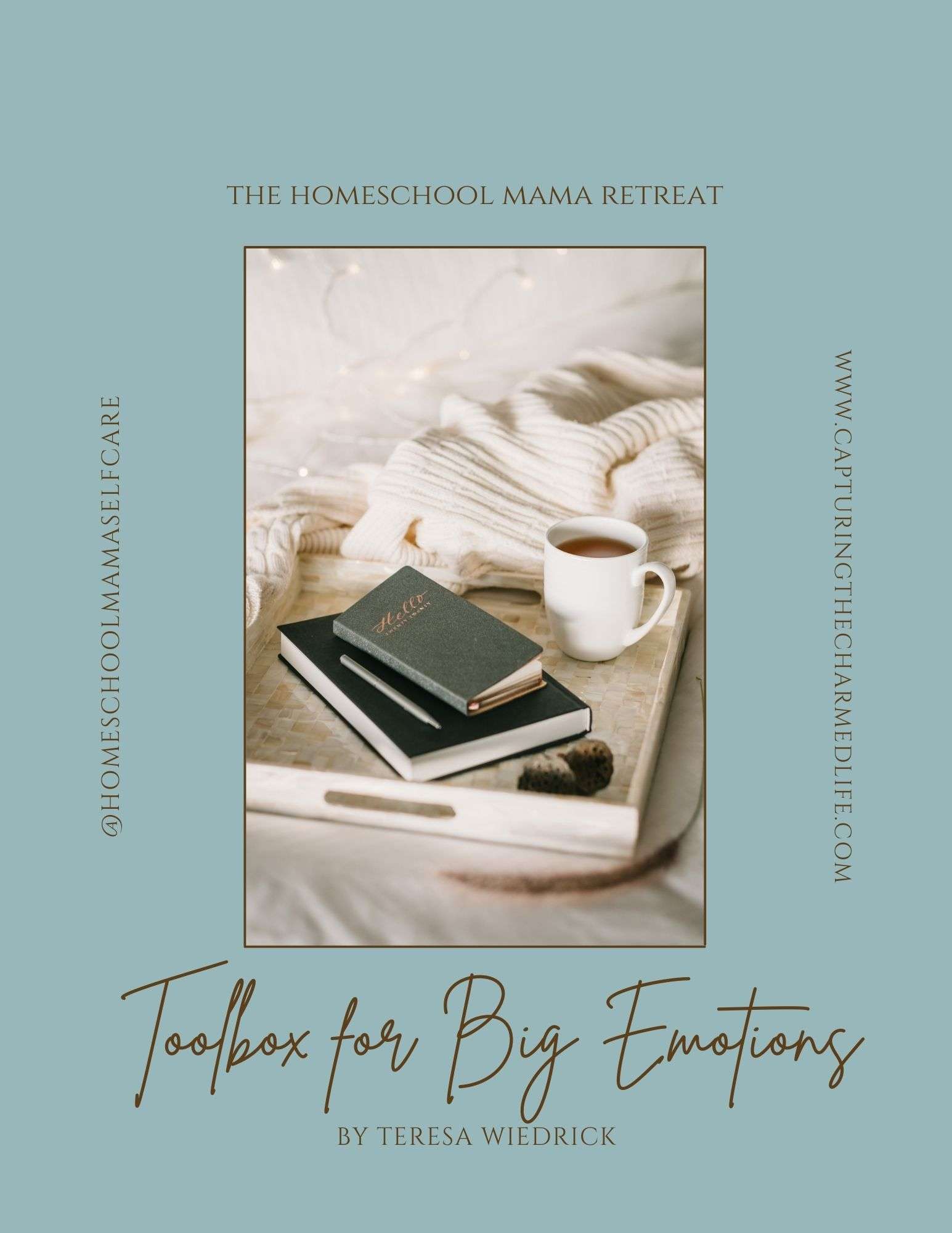Original price was: $9.99.$5.99Current price is: $5.99.
Introducing the Homeschool Mama’s Toolbox, a resource to help homeschooling mothers manage emotions and enhance mindfulness. It includes Dr. Amen’s three questions for self-reflection. Daily meditation practices and a Thought Care Checklist aid in handling challenging situations. Sharpen your mental tools and improve your homeschooling journey today!
Description
Use the Big Emotions Journal for the Homeschool Mom to help you address YOUR big emotions in your homeschool.
The Big Emotions Journal for the Homeschool Mom offers journal questions that can…
- aid in your self-exploration,
- help clarify your big emotions,
- and what your thought patterns are hijacking your homeschool days.
You already have all the tools: your emotions, your body, and your thoughts.
But if you don’t have a plan for your big emotions, use the journal to clarify and plan.
Get out your pen and dig deep into the following questions to assess how you’ve been using your tools.
Preview the Big Emotions Journaling Workbook here.
These big emotions journal questions aid in your self-exploration.
Get curious about what you’re feeling, how you’re taking care of yourself, and what your general thought patterns are during your homeschool days.
…So you can show up on purpose in your homeschool.
You know, the homeschool mama’s big emotions…
Our triggers, our reactions, and our emotional experiences are an inevitability because we’re human beings having human experiences. And specifically in a homeschool construct.
I began writing at Capturing the Charmed Life because I wanted to capture all the charms of this homeschool life, but I quickly discovered there were as many challenges as charms to homeschooling.
Here’s my story...
Somewhere in my third year of homeschooling, I was mouthing the words “help me” as the school bus drove by.
I was highly reactive to my kids’ squabbles, unkindnesses, or perpetually irritated that a child wouldn’t show interest in their studies, by saying, “If you don’t…then you’re getting on that bus Monday morning.”
Since I knew I didn’t actually want to research the local school’s telephone number, but I definitely didn’t know what else to do. Ultimately, I was done.
- I didn’t have time for myself or my body.
- No question, I felt overwhelmed.
- I was bored by yet another repeat of the same curriculum.
- And I did everything as perfectly as I could but had this feeling it wasn’t being done good enough.
- I wondered if I was doing right by my kids.
Until I watched a Brene Brown TedX Talk and realized I didn’t even factor ME into my life.
Alongside planning for my homeschool, I needed to plan for myself too.
The initial things I thought were going to be the most challenging aspects of homeschooling, academics & socialization, weren’t.
The most challenging thing had to do with me: dealing with all my big emotions.
I’ve spent a whole bunch of years, learning how to address my big emotions.
And I’ve learned there are a few tools in our Big Emotions Toolbox that we can use.
But just because we have those tools (because we all have the tools), doesn’t mean we know how to wield them.
When we built our homestead on three acres of raw land on the edge of the Kootenay River, we blasted through granite to plum a well and created a flat space for a driveway, a garden, and a house foundation.
We designed & built a house, an outdoor fire pit, a kids’ zip line, a chicken coop (20 hens in Cluckingham Palace), a goat barn for Clover, Thistle & Poppy, and a space for their guard dog, Violet.
A whole lotta tools have been used on our homestead.
The tool we use the most: an ax and a chainsaw. (Neither my husband nor I grew up using these tools but we have learned: you can’t leave tools out in the rain or they’ll rust and ruin. Also, you have to regularly sharpen your tools.)
So what are your tools for dealing with your big emotions?
The homeschool mama’s tools:
(See, I told you you had them!)
This is the first tool in your Homeschool Mama Big Emotion Toolbox so you can address your Big Emotions.
Your Thoughts…
Your brain and your thoughts are significantly underrated tools.
A tool that we have to regularly sharpen, but for many years we might often not even realize is there.
We can influence our thoughts, and good things, because our thoughts define our reality, but we don’t have to have our reality be defined by our unhelpful thoughts.
Hmmm…If this notion is new to you, stop for a minute, sit with me for a moment.
- Will you sit with your feet on the ground and back straight up?
- Will you breathe in for five beats…one-two-three-four-five…
- Hold that breath for five…one-two-three-four-five…
- Exhale for five beats…one-two-three-four-five…
Okay, what thoughts are you thinking?
When you do this often enough, you’ll realize there is a presence, energy, or awareness that is beyond your thoughts.
The thoughts we think are like clouds in the sky. They come, they go, they’re fluffy and summery, now they’re stormy and windblown, but the clouds in the sky? Never the same.
Same thing with our thoughts.
Do you want to know how to deal with your thoughts?
…Like your thoughts are separate from you…
Incorporate a mindfulness practice into your homeschool.
There is a reason you hear so much about this. It works! You can get separate from your regularly experienced thoughts.
There are three questions I learned from Dr. Amen, author of Change your Brain, Change your Life:
- What am I feeling?
- What is the thought behind my feeling?
- What is the story behind my thought? (There is always a story I’m telling myself).
This is a practice you have to practice regularly to get the most out of it.
Your ultimate goal: get to know yourself and practice being present.
So how are you going to practice this?
You’re going to schedule that mindful moment on your device.
When that timer goes off once or twice a day, take a deep breath and ask yourself:
- How do you feel?
- What is the thought behind your feeling?
- What is the story I’m telling myself behind that thought?
Include a meditation practice in your day.
Say what??? Mindfulness practice AND a meditation practice?
Well, I’ll ask you this:
Wouldn’t it be nice to be distant from your thoughts for just a few minutes a day, to just BE, and to be more present?
This is the practical how-to to doing just that.
Here are a few meditations you can begin with:
- Guided Meditation on Controlling Negative Thoughts
- Guided Meditation for Inner Peace & Calm
- Guided Mindful Meditation on Dealing with Anger
- Guided Meditation for Dealing with Suppressed Emotions
Also, just as I think we’re deeply affected by the things we hear others say toward us or about us and most importantly, what we say toward us or about us, that’s why I encourage you to recite a daily affirmation.
So let’s stop for a moment from discussing theory and get into the practical homeschool experience.
How do you respond when…
- Your child won’t sit to do their studies?
- Your child knew his times’ tables three weeks ago, but now, magically, he can’t recall them.
- Your kids are complaining about the Ancient Greek party you put together in your spare time (and they even wanted to study Egypt), and you bought all the things, gauzy drapes at the second-hand store for their togas, grapevines to create head wreaths, grapes, olives, and a fancy gold cord for their waists. And now they don’t wanna do it!
What are the thoughts you’re thinking?
- Do you feel angry?
- Do you feel unappreciated?
- Do you feel that no one cares about you and what you want?
- Do you feel like no one values the work you do?
- Do you feel like your child is lazy?
- Do you feel like your child is unmotivated?
Is there a story behind that thought?
- My kid is just trying to make me mad.
- He always wants something but is never willing to help me out.
- No one thinks about what I need.
- No one values the effort I put into making homeschooling fun. I even asked them what they wanted!
- My child is surely going to grow up living hand-to-mouth and not have what he needs.
- My child isn’t learning anything. Everyone is asking why we homeschool and I can’t say it’s for academics because obviously, he’s not learning anything.
What is an alternative perspective?
- My kid is bored with his studies.
- My kid is understimulated by his studies.
- My kid is overstimulated by too many activities.
- Is what your child doing a statement about you at all or is it about him not feeling good somehow?
- Do your kids need to value what you’re doing as a homeschool mom? (They’re kids, if you look to their validation, you won’t consistently find it. Maybe on Mother’s Day and your birthday and hugs and kisses scattered here and there, but your children aren’t your source of validation.)
- You can’t forecast the future for your child. It might be instinct to be concerned now, but there are a lot of steps between him not wanting to add mixed fractions and him not wanting to be a functional adult.
Why consider alternative perspectives?
Oh, I dunno, because if we are growing human beings, we can learn that we don’t have everything understood and figured straight off.
Remember before you had a child or a baby: how did you perceive parenting?
I was an RN in the post-partum ward with my list of helpful answers filled with all the stuff a new parent needed as they took home their baby.
Remember before you were long-term partnered or married, did you assume you found the perfect person and that you’d ride off into the sunset and live a fairy tale life, no conflict included?
Remember before you homeschooled, did you think about an education differently, and has your perspective on what an education is anyway expanded over the course of your homeschool months or years?
Our perspectives can shift and expand with our growing understanding.
This is also true with the challenges we face in our homeschool. If there is an alternative perspective, could we work to find it, because it might benefit us and our children?
This is the second tool in your Homeschool Mama’s Big Emotion Toolbox so you can address your Big Emotions.
Download the Big Emotions Journal for the Homeschool Mom
“Our chief want is someone who will inspire us to be what we know we could be.”
— Ralph Waldo Emerson
People also ask:
- Grab the Big Emotions Journal for the Homeschool Mom
- Listen to the Podcast Episodes on Dealing with Big Emotions for the Homeschool Mom
- Where do I find the Grappling with Overwhelm Journaling Workbook? You can find that here.
- how to positively influence my homeschool mama thoughts so I can enjoy my homeschool
- Tell me about your virtual homeschool mama retreat.





